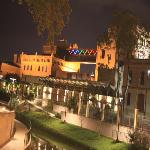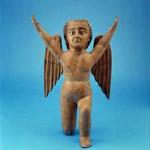April 01, 2011

Photo: San Antonio Museum of Art
You’d be hard-pressed to recognize the elegant San Antonio Museum of Art building as having once housed a bustling, smelly brewery.
Members of the wealthy Rockefeller family of New York helped establish the Museum of Modern Art and revive the old Cloisters medieval museum, both in New York City. The Rockefellers contributed to the restoration of Versailles Palace in France. And the estate of former New York governor Nelson Rockefeller made possible the most comprehensive collection of Latin American art in the United States, in San Antonio, Texas.
Sixty percent of San Antonians have Spanish surnames. America's seventh-largest city is full of colorful murals, window decorations, and wildly painted automobiles created by Hispanics. Yet the San Antonio Museum of Art, which is housed in a 225-year old refurbished brewery complex, built its reputation primarily on its antiquities collection from Egypt, Greece, and Rome.

San Antonio Museum of Art
This cherub from the museum's collection was fashioned of painted wood and glass eyes in the mid-1700s, after Spanish Catholics had introduced the concept of angels.
But several years ago, the museum hosted a touring exhibition featuring 30 centuries of Mexican artistic splendor. Over three months, 300,000 people visited the exhibit.
This success story got the San Antonio Museum to focus on the Hispanic culture around it. Its board of directors voted to build a new center of Latin American art within the museum. When it opened in 1998, the center was named for Nelson Rockefeller, whose family contributed several pieces of Mexican folk art that Rockefeller had owned. He had scoured Latin America for unusual contemporary art and helped legitimize the Latin folk-art genre.
His collection includes a painting depicting Mexican artist Diego Rivera's visit to Moscow in the 1920s. That's ironic, since it was the Rockefeller family that commissioned the Marxist painter to create a fabulous mural in New York's new Rockefeller Center, only to order it destroyed because Rivera included a depiction of Russian leader Vladimir Lenin, as well as scenes deemed to be socialist.

San Antonio Museum of Art
The San Antonio Museum of Art built its reputation on its outstanding collection of Greek and Roman art, including this piece, a gift of Gilbert M. Denman, Jr.
Other U.S. museums can boast of fine collections of pre-Columbian art -- that is, art created before Europeans explored the Americas -- or Spanish Colonial, republican, folk, or contemporary Latin art. But none covers all five categories as completely as the San Antonio Museum's 3,000-square-meter Nelson A. Rockefeller Center. Its 8,000 pieces of art -- only a few hundred of which can be displayed at one time -- range from Peruvian textiles to Costa Rican stone warriors to a wide variety of religious statues and paintings.
Marion Oettinger, Junior, the collection's first curator, told us that the Rockefeller center is, in his words, "a way of peering into the soul, the values, the perspectives, and the sense of well-being of Latin America through artifacts."
Oettinger, who is now director of the entire museum, says an even more important mission may be to remind some of the 12 million annual visitors to San Antonio who DON'T share a Latin heritage, and perhaps have never even seen a Hispanic neighborhood, of the cultural importance of Latin America. At the San Antonio Museum of Art, they can walk among four thousand years of Latin American art.
In fact, says director Oettinger, "There's an expression, el alma entre los dedos -- ‘the soul between the fingers.'" This, he says, is where the folk artist's creativity and passion reside -- between the fingers.
Two years ago, San Antonio extended its world-famous River Walk canal and strolling path three kilometers to the very door of the museum. That exposed even more visitors to the single-most comprehensive collection of Latin American art north of Mexico City.